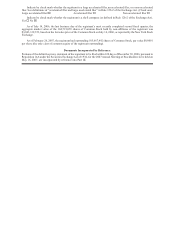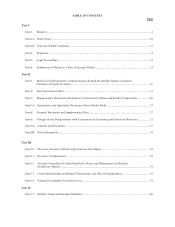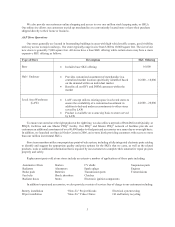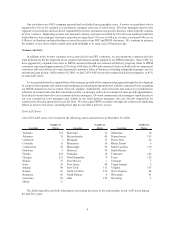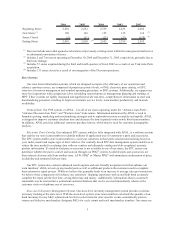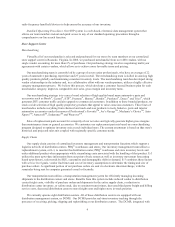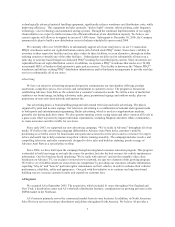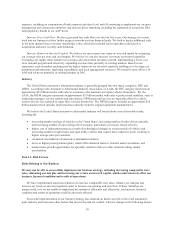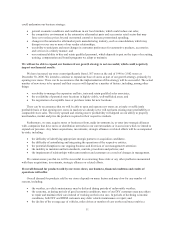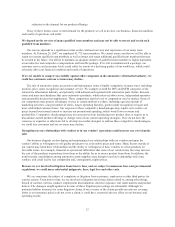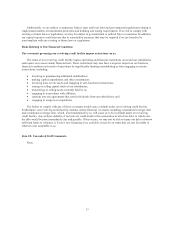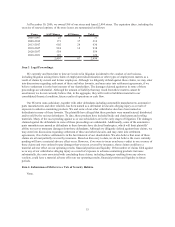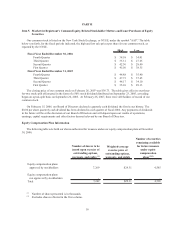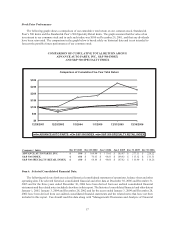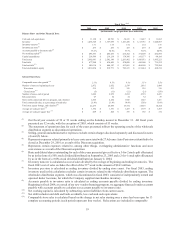Advance Auto Parts 2006 Annual Report Download - page 32
Download and view the complete annual report
Please find page 32 of the 2006 Advance Auto Parts annual report below. You can navigate through the pages in the report by either clicking on the pages listed below, or by using the keyword search tool below to find specific information within the annual report.Competition
Our primary competitors are both national and regional retail chains of automotive parts stores, including
AutoZone, Inc., O'Reilly Automotive, Inc., CSK Auto Corporation and The Pep Boys–Manny, Moe & Jack,
discount stores and mass merchandisers that carry automotive products, wholesalers or jobber stores, including those
associated with national parts distributors or associations, such as NAPA and Carquest, independent operators and
automobile dealers that supply parts. We believe that chains of automotive parts stores that, like us, have multiple
locations in one or more markets, have competitive advantages in customer service, marketing, inventory selection,
purchasing and distribution as compared to independent retailers and jobbers that are not part of a chain or
associated with other retailers or jobbers. The principal competitive factors that affect our business include store
location, availability, customer service and product offerings, quality and price.
Environmental Matters
We are subject to various federal, state and local laws and governmental regulations relating to the operation of
our business, including those governing recycling of batteries and used lubricants, and regarding ownership and
operation of real property. We handle hazardous materials as part of our operations, and our customers may also use
hazardous materials on our properties or bring hazardous materials or used oil onto our properties. We currently
provide collection and recycling programs for used automotive batteries and used lubricants at all of our stores as a
service to our customers. Pursuant to agreements with third party vendors, used batteries and lubricants are collected
by our team members, deposited into vendor supplied containers or pallets and stored by us until collected by the
third party vendors for recycling or proper disposal. Persons who arrange for the disposal, treatment or other
handling of hazardous or toxic substances may be liable for the costs of removal or remediation at any affected
disposal, treatment or other site affected by such substances.
We own and lease real property. Under various environmental laws and regulations, a current or previous owner
or operator of real property may be liable for the cost of removal or remediation of hazardous or toxic substances on,
under or in such property. These laws often impose joint and several liability and may be imposed without regard to
whether the owner or operator knew of, or was responsible for, the release of such hazardous or toxic substances.
Other environmental laws and common law principles also could be used to impose liability for releases of
hazardous materials into the environment or work place, and third parties may seek recovery from owners or
operators of real properties for personal injury or property damage associated with exposure to released hazardous
substances. From time to time, we receive notices from the Environmental Protection Agency and state
environmental authorities indicating that there may be contamination on properties we own, lease or operate or may
have owned, leased or operated in the past or on adjacent properties for which we may be responsible. Compliance
with these laws and regulations has not had a material impact on our operations to date.
Growth Strategy
Our growth strategies consist of the following:
Increase Our Average Sales per Store. In 2006, our average sales per AAP store reached an industry leading
level of $1.55 million per store. We plan to continue increasing our average sales per store by, among other things:
(1) improving store execution with a focus on customer service; (2) execution of our category management program;
(3) continued maturation of our sales initiatives for our DIY customers including local purchase ordering, factory
direct ordering, salvage body parts and our custom mix (store specific merchandise assortment); (4) the
implementation of our 2010 store remodeling program, with now more than 65% of our chain remodeled and
targeting a total of 150 AAP stores to be remodeled annually; (5) consistent growth and execution of our
commercial program, including optimization of delivery vehicles; (6) enhanced merchandising and marketing
programs and (7) focus on making our supply chain more responsive.
Expand Our Operating Margin. In addition to driving operating margin expansion through increased average
sales per store and continued comparable store sales growth, we will continue to focus on increasing margins by:
(1) improving our purchasing efficiencies with vendors; (2) utilizing our supply chain infrastructure and existing
distribution network to optimize our inventory mix and maximize distribution capacity; (3) controlling our operating
9


